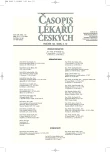Innate Immunity, Receptors for Exogenous and Endogenous Danger Patterns in Immunopathogenesis of Atherosclerosis – Part II: TLR Receptors, Significance of Genetic Polymorphism of Danger Signals Receptors
Authors:
J. Krejsek; P. Kuneš 1; C. Andrýs; M. Holická; J. Novosad; M. Kudlová; M. Koláčková
Authors‘ workplace:
Ústav klinické imunologie a alergologie LF UK a FN, Hradec Králové
; Kardiochirurgická klinika FN, Hradec Králové
1
Published in:
Čas. Lék. čes. 2005; 144: 790-794
Category:
Review Article
Overview
The most important set of receptors for danger patterns are TLR receptors. Together ten different TLR receptors were identified so far. Majority of TLR receptors is expressed on the cell surface to identify extracellulary localized danger signals. Some TLR receptors are also expressed in the intracellular compartment to identify intracellular danger signals. Receptors for danger signals display individual differences delineated by genetic polymorphism. The individual immune reactivity is developed in the context of genetic predisposition and the exposition to variable environmental factors. The differences in an individual immune reactivity are probably responsible for individual susceptibility or resistance to the development of immunopathological reactivity, which is involved in the immunopathogenesis of atherosclerosis.
Key words:
TLR receptors, polymorphism, atherosclerosis, innate immunity.
Labels
Addictology Allergology and clinical immunology Angiology Audiology Clinical biochemistry Dermatology & STDs Paediatric gastroenterology Paediatric surgery Paediatric cardiology Paediatric neurology Paediatric ENT Paediatric psychiatry Paediatric rheumatology Diabetology Pharmacy Vascular surgery Pain management Dental HygienistArticle was published in
Journal of Czech Physicians

Most read in this issue
- Renal Angiomyolipoma, Histology, Diagnostics and Therapy
- Mosaicplasty in the Treatment of Knee Injuries
- Cognitive Dysfunction and Its Therapy
- Combined Immunosuppressive Therapy in Patients with Pemphigus Vulgaris and Its Side Effects
